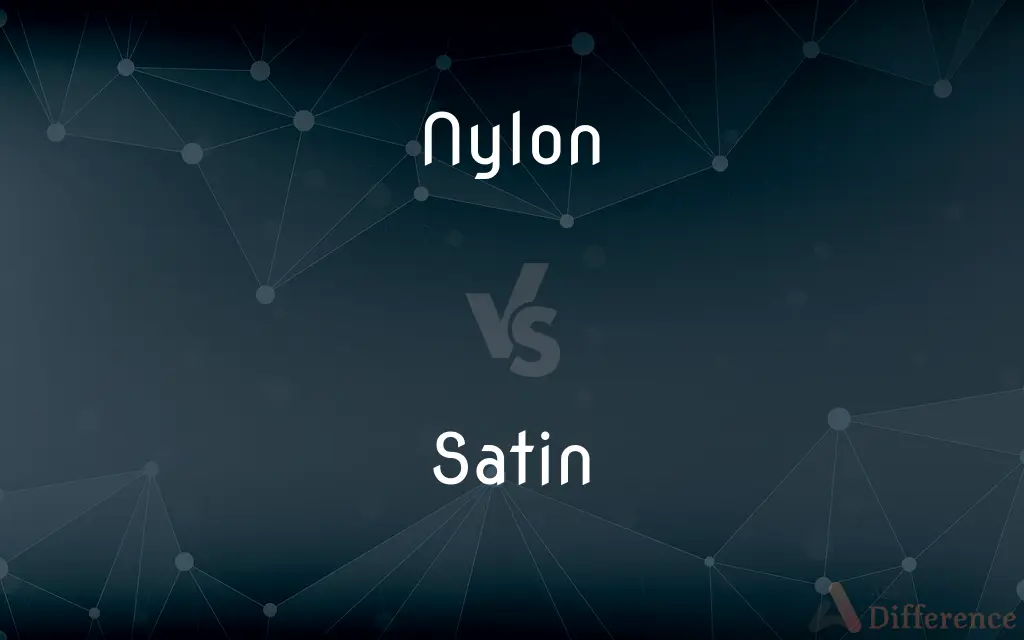Nylon vs. Satin — What's the Difference?
By Tayyaba Rehman & Maham Liaqat — Updated on March 12, 2024
Nylon is a durable, synthetic polymer, often used in textiles, whereas satin is a weave that creates a smooth, glossy fabric, not limited to any one fiber.

Difference Between Nylon and Satin
Table of Contents
ADVERTISEMENT
Key Differences
Nylon, a synthetic polymer, was developed as an alternative to silk, offering high strength and elasticity. It's widely used in various products, from clothing to automotive parts, due to its durability and resistance to wear and tear. On the other hand, satin refers to a weave pattern that produces a fabric with a glossy surface and a dull back, known for its smooth, silky feel. Satin can be made from silk, polyester, or even nylon, making its defining feature the weave rather than the material.
The creation of nylon revolutionized the textile industry by providing a cost-effective, strong, and versatile material. Its ability to stretch without losing its shape makes it ideal for sportswear and hosiery. Satin, with its luxurious sheen and smooth texture, is often chosen for formal wear, lingerie, and bedding. While the aesthetic appeal of satin lies in its luster and drape, nylon impresses with its practicality and resilience.
Nylon's synthetic nature means it's less breathable compared to natural fibers, which can make it uncomfortable in hot weather or during intense physical activity. Conversely, satin, especially when made from natural fibers like silk, offers better breathability, making it more comfortable to wear or sleep in during warmer conditions. However, satin made from synthetic fibers like polyester can mimic the appearance of silk satin at a lower cost but with reduced breathability.
In terms of care, nylon is generally more low-maintenance, being machine washable and resistant to shrinking and wrinkles. Satin's care requirements can vary significantly depending on the fibers used. Silk satin requires gentle handling, often needing hand washing or dry cleaning, while synthetic satins are more forgiving but still might require special care to maintain their sheen.
Environmental impact is another consideration. Nylon production is energy-intensive and relies on petrochemicals, contributing to environmental pollution. Meanwhile, the environmental impact of satin varies with the source material; silk production is resource-intensive but natural, whereas synthetic satins share similar environmental concerns to nylon.
ADVERTISEMENT
Comparison Chart
Material Type
Synthetic polymer
Weave pattern (made from silk, polyester, nylon, etc.)
Main Uses
Sportswear, hosiery, automotive parts
Formal wear, lingerie, bedding
Durability
High resistance to wear and tear
Depends on the fiber; can vary from moderate to high
Breathability
Lower compared to natural fibers
High if made from silk; lower for synthetic versions
Care and Maintenance
Generally machine washable, resistant to shrinking and wrinkles
Varies; silk requires gentle care, while synthetic versions are more durable
Compare with Definitions
Nylon
A strong, elastic synthetic polymer, used in fiber form for textiles.
Nylon stockings are popular for their durability and stretch.
Satin
A weave that produces a fabric with a glossy surface and dull back, known for its smooth texture.
Satin dresses are favored for their luxurious sheen and drape.
Nylon
Is not biodegradable, raising environmental concerns.
Discarded nylon fishing nets pose a threat to marine life.
Satin
While synthetic satins are more durable, they may lack the breathability and softness of silk satin.
Polyester satin can mimic silk's look but not its natural comfort.
Nylon
Resistant to both abrasion and chemicals, making it versatile for various applications.
Nylon is used in automotive parts due to its toughness.
Satin
Requires careful maintenance, especially silk satin, to preserve its texture and sheen.
Silk satin garments are typically dry-clean only to maintain their appearance.
Nylon
Can be molded into shapes, ideal for manufacturing a wide range of products.
Toothbrush bristles are often made from nylon for their stiffness.
Satin
Made from various fibers, including silk, polyester, and nylon, affecting its feel and price.
Silk satin sheets offer a premium feel but at a higher cost.
Nylon
Tends to be more affordable than natural fibers, offering a cost-effective alternative.
Nylon fabrics are a popular choice for budget-friendly activewear.
Satin
Often chosen for its aesthetic qualities in fashion and home décor.
Satin ribbons are used for decorative purposes because of their glossy finish.
Nylon
Nylon is a generic designation for a family of synthetic polymers composed of polyamides (repeating units linked by amide links). Nylon is a silk-like thermoplastic, generally made from petroleum, that can be melt-processed into fibers, films, or shapes.
Satin
A satin weave is a type of fabric weave that produces a characteristically glossy, smooth or lustrous material, typically with a glossy top surface and a dull back. It is one of three fundamental types of textile weaves alongside plain weave and twill weave.
Nylon
Any of a family of high-strength, resilient synthetic polymers, the molecules of which contain the recurring amide group CONH.
Satin
A smooth, often silk fabric that is woven with a glossy face and a dull back.
Nylon
Cloth or yarn made from one of these synthetic materials.
Satin
A garment made of this fabric.
Nylon
Nylons Stockings made of one of these synthetic materials.
Satin
A kind of paint that dries to a smooth shiny finish.
Nylon
Originally, the DuPont company trade name for polyamide, a copolymer whose molecules consist of alternating diamine and dicarboxylic acid monomers bonded together; now generically used for this type of polymer.
Satin
Made of or covered with satin.
Nylon
(in the plural) A stocking originally fabricated from nylon; also used generically for any long, sheer stocking worn on a woman's legs.
I tore a hole in my nylons while walking home through the woods.
Satin
Glossy, sleek, and smooth.
Nylon
(perjoratively, by comparison to silk) A Queen's Counsel, King's Counsel or Senior Counsel who was appointed as a courtesy, rather than on merit.
Satin
A cloth woven from silk, nylon or polyester with a glossy surface and a dull back. (The same weaving technique applied to cotton produces cloth termed sateen).
Nylon
Any of several thermoplastic polyamide plastics, comprising a family of high-strength resilient synthetic materials, used mostly in fibers.
Satin
Semigloss.
Satin paint
Nylon
A synthetic fabric consisting of fibers of nylon[wn1].
Satin
(transitive) To make (paper, silver, etc.) smooth and glossy like satin.
Nylon
Stockings made of a thin form of nylon{2}, especially full-length stockings either sheer of of varying shades.
Satin
A silk cloth, of a thick, close texture, and overshot woof, which has a glossy surface.
Cloths of gold and satins rich of hue.
Nylon
A thermoplastic polyamide; a family of high-strength resilient synthetic materials
Satin
A smooth fabric of silk or rayon; has a glossy face and a dull back
Nylon
A synthetic fabric
Common Curiosities
Can satin be made from nylon?
Yes, satin can be made from nylon, among other fibers, affecting its characteristics and use.
How does the care for nylon and satin compare?
Nylon is generally low-maintenance and machine washable, while satin requires more careful handling, especially if made from silk.
Is nylon more durable than satin?
Nylon is inherently durable due to its synthetic nature, but the durability of satin depends on the fibers used and the weave.
Which is more suitable for active wear, nylon or satin?
Nylon is more suitable for active wear due to its durability, elasticity, and moisture-wicking properties.
What is the main difference between nylon and satin?
The main difference lies in their nature; nylon is a synthetic polymer material, while satin is a type of weave that results in a glossy fabric made from various fibers.
Can both nylon and satin be used in outdoor gear?
Nylon is commonly used in outdoor gear for its strength and weather resistance, while satin is less common due to its focus on aesthetic qualities rather than functionality.
Are there hypoallergenic options for nylon or satin?
Satin made from natural fibers like silk can be hypoallergenic, while nylon's synthetic nature may not be suitable for those with sensitive skin.
Which is more expensive, nylon or silk satin?
Silk satin is typically more expensive than nylon due to its natural origin and luxurious quality.
Is nylon or satin better for the environment?
Both have environmental impacts; nylon's production is energy-intensive and not biodegradable, while the impact of satin depends on whether it's made from natural (silk) or synthetic fibers.
Which is better for formal attire, nylon or satin?
Satin, especially silk satin, is preferred for formal attire due to its elegant sheen and drape.
Share Your Discovery

Previous Comparison
Pancake vs. Pikelet
Next Comparison
Frost vs. SnowAuthor Spotlight
Written by
Tayyaba RehmanTayyaba Rehman is a distinguished writer, currently serving as a primary contributor to askdifference.com. As a researcher in semantics and etymology, Tayyaba's passion for the complexity of languages and their distinctions has found a perfect home on the platform. Tayyaba delves into the intricacies of language, distinguishing between commonly confused words and phrases, thereby providing clarity for readers worldwide.
Co-written by
Maham Liaqat















































